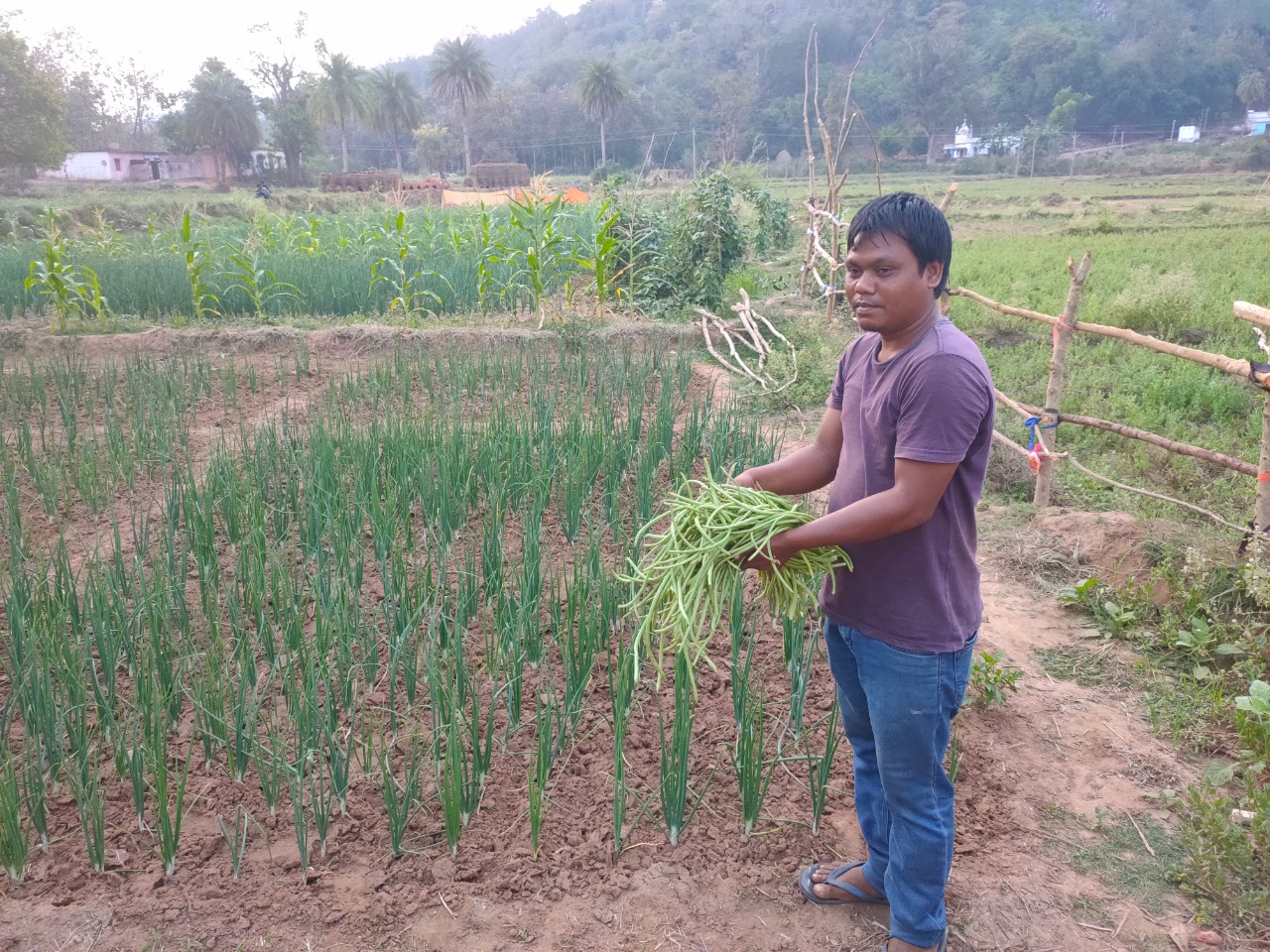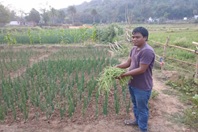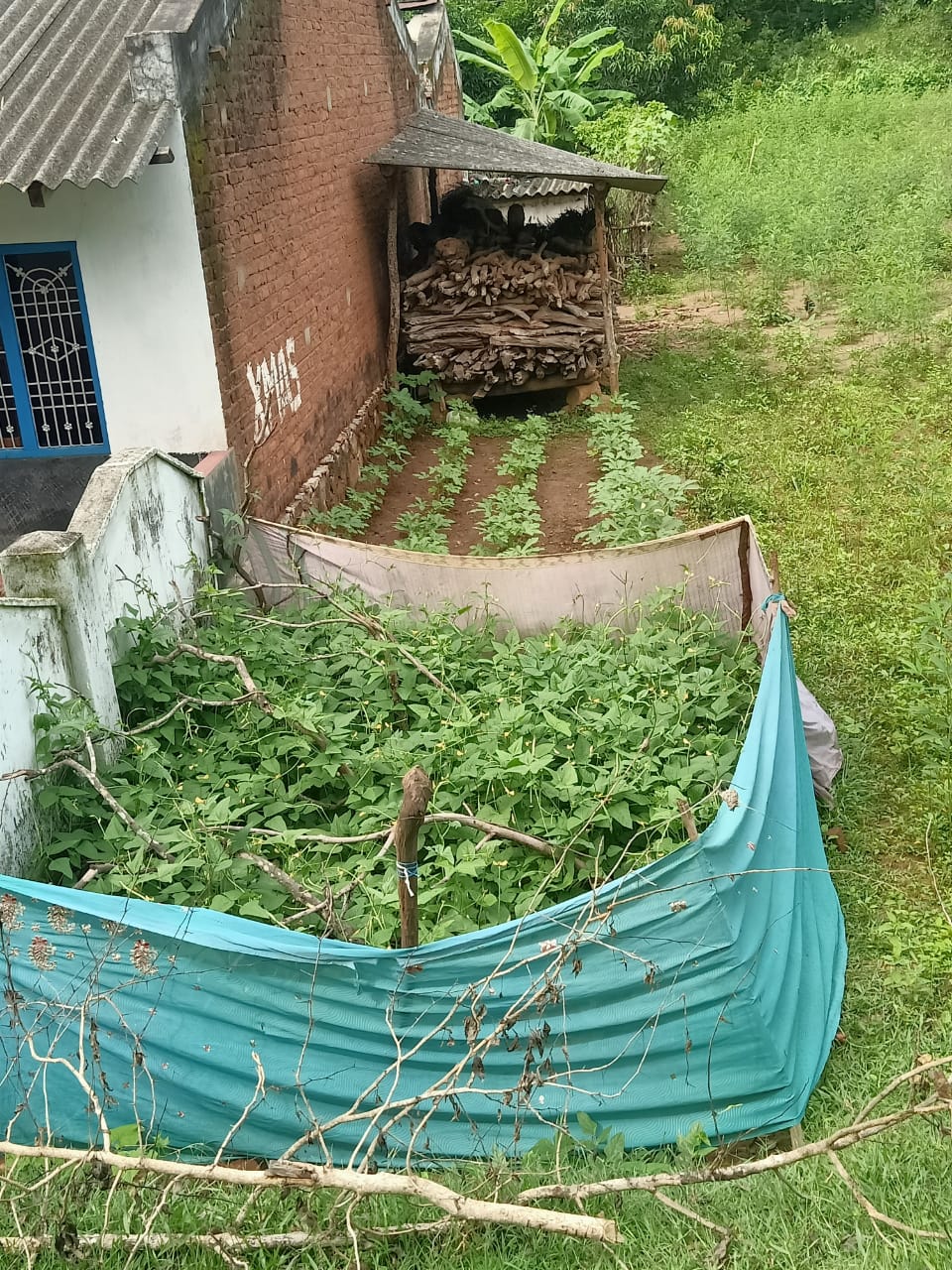WOTR promotes a total of 700 kitchen gardens in 11 villages of Kulusing, Jaltar, Putasing and Tolana panchayats of Gunupur block in the Rayagada district of Odisha. Fruits and vegetables grown in these gardens play an important role in filling the gaps in nutritional requirements by providing freshly-harvested organic produce to vulnerable households.
by Kasturi Samal

Gunupur is a tribal block of Odisha where vulnerable communities such as Lanjia Soura and Kandha reside. Their land holding is very low: 0.6 hectare on an average for a household of at least five members. The only source of income is agriculture — mainly paddy, which is consumed and the excess sold. The lands are rainfed. Only one crop is cultivated during the monsoon. Some varieties of pulses such as arhar are grown in the valley.
Households here are not used to growing and eating green and leafy vegetables. Consuming the same after buying from the market is unaffordable for the community. So, they end up eating arhar and rice quite often. Normally, they consume rice three times a day.
In fact, most households lack a full course of vitamins and nutrients in the diet. Only source of protein is poultry meat which they eat at an interval of 20-25 days depending on the financial status of the household.
Lack of awareness on cooking good food with available resources is a major cause of concern. Many children and lactating mothers are malnourished. Food insecurity contributes to obesity and under-nutrition.

Kitchen gardens can immensely help to improve food security and income generation and thus sustain livelihoods. Fruits and vegetables grown in these backyard gardens play an important role in filling the gaps in nutritional needs by providing access to freshly-harvested organic produce to family members. Kitchen gardens are also a cost-effective easy way to provide nutrition.
WOTR promotes a total of 700 kitchen gardens in eleven villages of Kulusing, Jaltar, Putasing and Tolana panchayats of Gunupur block in the Rayagada district of Odisha. A kitchen garden kit mainly consists of 10 varieties of vegetables including palak greens, kusala greens, okra, long beans, chilli, tomato, brinjal, papaya, moringa and ridge gourd seeds.

Preparing a raised bed is compulsory before the seeds are sown. As the land holding is low, depending upon available land in the backyard of each household, the beds are prepared. The size varies from 3” x 15” to 3” x 8”. Accordingly, the number of beds are fixed depending on the size of plot.
The source of irrigation for these beds is usually the waste water from respective households. The quantity of seeds provided will be enough to provide vegetables for a household of five members for a period of six months.

The chart below shows the nutritional value of specific vegetables in a typical kitchen garden, which is necessary to maintain natural metabolism.
| Vegetable | Nutritional value | Image | |
| 1 | Palak | Palak is a good source of Vitamin-C, K, Folic acid, Iron and Calcium |  |
| 2 | Kusala Saga | Kusala Saga green leaves are a good source of vitamins, minerals, carbohydrates, iron, protein and calcium |  |
| 3 | Okra | Okra is a good source of vitamins, minerals and fibre |  |
| 4 | Long beans
|
It is a good source of Vitamin-A and Vitamin-C |  |
| 5 | Chilli | Chillies contain Vitamin-A, B6, Iron and Copper |  |
| 6 | Tomato
|
Tomatoes are a good source of vitamins and minerals |  |
| 7 | Brinjal | Brinjal has Vitamin-B6, Copper, Vitamin-K and fibre |  |
| 8 | Ridge gourd | This gourd has Vitamin-C, Iron, Zinc and Magnesium |  |
| 9 | Papaya | Papayas are a good source of Vitamin-A, Copper and Magnesium |  |
| 10 | Drumsticks or Moringa | These are a good source of Vitamin-A, B1, B2, B6, Iron, Potassium and Calcium |  |
Mandu Sabar and his family are now food secure, thanks to WOTR
Mandu Sabar is about 35 years of age. He and his family live in Aredul village of Tolana gram panchayat.

Sabar is specially abled. He has five members to support in his family. Sabar’s right hand was disabled by birth, which is quite the challenge for him. His wife helps him in both domestic and farm work. They have twin sons nearly 16 years old and a daughter of about 12 years of age.
As per WOTR’s observation during the HH survey, the Sabars don’t have any cultivable patta land except one acre of non-patta land that is uneven and scruffy. So they are unable to cultivate paddy, though the staple food of the family is rice. The Sabars have an Antyodaya Anna Yojana (AAY) PDS card under the National Food Security Act, through which they are entitled to 35 kg of rice per month. This ration is not sufficient to feed the family. At times, the Sabars have to borrow rice from neighbours. However, in the uneven non-patta land, Sabars have been cultivating pulses — mostly arhar dal and long beans.
This year, with the support of WOTR, the Sabars have raised a model kitchen garden, which consists of 14 varieties of vegetables and fruits including palak and kusala green leaves, okra, long beans, chilli, tomato, brinjal, papaya, drumstick and ridge gourd. Banana, drumstick, maize and bottle gourd, Sabar has planted at his own expense.

Reducing financial stress
“Being poor means buying vegetables is a huge burden for us. We could not buy vegetables because we could not afford them”, says Tisini Sabar, Mandu Sabar’s wife.
She is happy now as she has access to sufficient produce for her family after growing over 14 varieties of vegetables and greens.

A balanced diet
Sabar’s children are happy with the new kitchen garden because of the choice it offers. “Earlier we ate whatever our mother served. Now I get to pick a hand full of greens and vegetables,” says one of the children. According to Sabar, the kitchen garden has fulfilled the nutritional needs of his family.

Organic produce
The farmers show interest in kitchen gardens, as there is no financial investment, apart from labour. Also, they can feed their family with fresh vegetables grown without using chemical fertilisers or pesticides.






